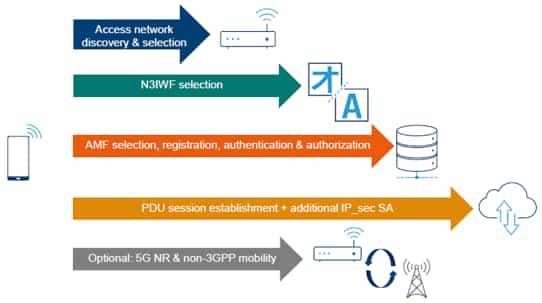5G Interworking with WLAN : Benefits & Limitations
Advertisement
The interworking of 5G and WLAN represents a crucial step toward achieving seamless, high performance connectivity in next-generation networks.
5G-WLAN Interworking is a core feature of the 5G architecture that allows a user’s device (like a smartphone) to establish a secure and trusted connection to its mobile operator’s 5G core network through a Wi-Fi access point.
This is far more advanced than a phone simply switching to Wi-Fi for internet access. When interworking is active, the device doesn’t just get a generic internet connection from the Wi-Fi router. Instead, it uses the Wi-Fi network as a transport path to build an encrypted tunnel back to its home mobile operator.
The key component that makes this possible is the N3IWF (Non-3GPP Interworking Function). This acts as a secure gateway and performs following tasks:
- It sits inside the mobile operator’s network.
- It serves as the bridge between the “untrusted” Wi-Fi network and the trusted, secure 5G core.
- The device establishes a highly secure IPsec tunnel to the N3IWF, ensuring all data that travels over the open Wi-Fi network is completely private and protected.
 Image Courtesy : Rohde & Schwarz
Image Courtesy : Rohde & Schwarz
Once this secure connection is established, the device is essentially “on the 5G network,” even though its radio link is Wi-Fi. This enables powerful traffic management capabilities known as ATSSS (Access Traffic Steering, Switching, and Splitting), which allows the device to intelligently use both 5G and Wi-Fi simultaneously.
Benefits of 5G-WLAN Interworking
Following are some of the advantages of 5G WLAN interworking.
- Seamless Connectivity and Intelligent Offload: The primary benefit is a vastly improved and more resilient user experience. Using ATSSS, a device can intelligently steer traffic to the best available network. If you walk into your home and the Wi-Fi is stronger, a video call can be seamlessly moved from 5G to Wi-Fi without any interruption. This also allows mobile operators to intelligently offload heavy data traffic from their licensed cellular spectrum onto Wi-Fi, freeing up valuable 5G capacity.
- Enhanced Performance through Bandwidth Aggregation: The “Splitting” capability of ATSSS allows a device to use both the 5G and Wi-Fi data pipes at the same time for a single application.
- Expanded Coverage and In-Building Penetration: Cellular signals, especially high-frequency 5G signals, can struggle to penetrate deep inside buildings. Wi-Fi is often ubiquitous indoors. Interworking allows the mobile operator to leverage this existing Wi-Fi infrastructure to fill in cellular coverage gaps.
- Unified Access to 5G Core Network Services: Because the device is securely connected to the 5G core via the N3IWF, it can access the full suite of the operator’s services, policies and security features, just as if it were on the cellular network.
Challenges and Limitations
Following are some of the disadvantages of 5G WLAN interworking.
- Increased Device Power Consumption: To enable intelligent features like ATSSS, the device must keep both its 5G and Wi-Fi radios active which consume more battery power than using a single connection, which can be a major drawback for mobile devices.
- Performance Unpredictability of Wi-Fi: Wi-Fi operates in unlicensed spectrum, which is a shared and often chaotic environment. Performance can fluctuate dramatically due to interference from neighboring networks.
- Security Risks of Untrusted Networks: While the IPsec tunnel to the N3IWF provides a very strong layer of security for the user’s data, the initial connection is still made to a potentially “untrusted” Wi-Fi network (like a public hotspot). This can expose the device to local network-level security risks before the secure tunnel is fully established.
- Complexity for Network Operators: Implementing this functionality adds significant complexity to the mobile operator’s network. They must deploy, manage, and scale the N3IWF gateway. Furthermore, they need a robust Policy Control Function (PCF) to define and manage the complex ATSSS steering rules for millions of subscribers and thousands of different applications, adding to their operational overhead.
Summary: Overall, 5G-WLAN interworking offers a promising pathway toward ubiquitous connectivity and optimized resource utilization, but realizing its full potential will depend on standardized architectures, robust security frameworks, and intelligent network coordination mechanisms. Future advancements in 3GPP standards and AI-driven network management are expected to further refine this integration, paving the way for a more unified and efficient wireless ecosystem.
Advertisement
 RF
RF







